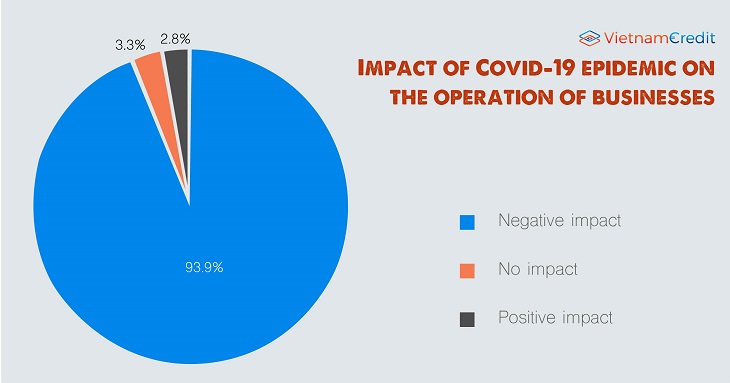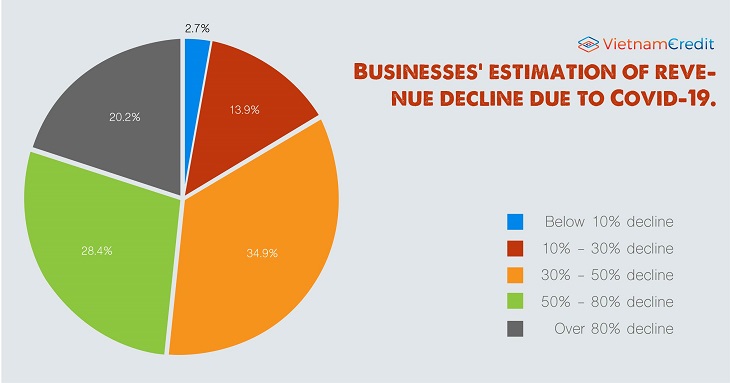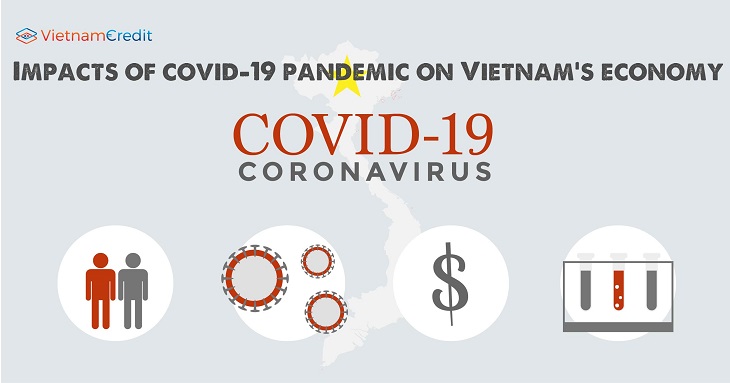Vietnam's second quarter GDP growth may only be around 2.0% and expected to recover from the third quarter of 2020.
Vnindex will decrease about 28% and recover immediately after the epidemic is controlled …
Impacts on economic growth
So far, there have been a number of domestic and foreign research organizations forecasting the impact of the COVID-19 pandemic on Vietnam’s economy. However, these forecasts were made based on the epidemic situation before Europe and the US were seriously affected.
Bloomberg forecast that Vietnam's growth would decrease by 0.4% while ADB believed that there would be a 0.5-1% or even 1.5% decrease in Vietnam’s economic growth. The Ministry of Planning and Investment forecast that the growth may decrease from 0.67 to 0.96%, and inflation would be between 3.96% and 4.86%, etc. (report in February). The State Bank of Vietnam forecast inflation to be around 4.5% +/- 0.4% (March 12 report). In the latest report (March 31, 2020), the World Bank predicted that Vietnam's economy in 2020 would experience a growth at about 1.5% to 4.9%, and would recover strongly in 2021.
However, with the move of outbreak's center from China to Europe, the US and other regions, the impact of Covid-19 on the Vietnamese economy will be stronger with a sharp decrease in demand for goods. Therefore, Vietnam's GDP growth will only be around 2.0% in the second quarter.
In addition, there could be even recession if a bad scenario occurs. It is expected to recover from the third quarter of 2020. Vnindex will decrease about 28% and recover to approximately 20% right after the epidemic is controlled. Exports will decrease by 25% in the second quarter and recover to a decrease of 15% in the following quarters of 2020.
Impacts on businesses
The survey of 510 enterprises, most of which are non-state enterprises, conducted in early April by the National Economics University, shows the impact of the Covid-19 pandemic on businesses more clearly.

Source: National Economics University
The survey results show that, so far, the impact of COVID-19 on businesses has begun to manifest clearly in all industries which are directly and indirectly affected. It is indicated that up to 93.9% of surveyed businesses believed that that Covid-19 is having a negative impact on their production and business activities.
Production and business activities seriously affected
The epidemic has caused businesses to face many difficulties at the same time. Survey results show that 60.2% of businesses are facing a decline in revenue as they have to cover many other expenses. Over a half of surveyed businesses (51.8%) shared that their production and business activities operate below normal level.
In addition, 43.4% of these businesses face difficulties due to lack of revenue; 39.4% could not carry out production and business activities. Moreover, 31.2% of businesses responded that their goods could not be sold domestically, while goods of 17.20% of surveyed businesses could not be exported.
The problem of capital shortage (36.7%) and shortage of production materials, especially imported raw materials (29.1%) are also big difficulties. Falling revenue is the most major problem encountered by many businesses during the epidemic outbreak.
Specifically, 20.2% of businesses that were negatively affected said that their revenue decreased by 80% or more; 28.4% of businesses suffered a decrease of 50% to 80% in revenue, etc. while only 2.7% of businesses had a decrease of less than 10% in revenue.

Source: National Economics University
While revenue is heavily reduced, businesses still incur large expenses. Survey results show that labor costs are the biggest burden for 34.5% of businesses under the impact of Covid-19 epidemic. Followed by interest payment on bank loans (25.0%), regular operating expenses (20.6%), and rental cost of premises (17.9%).
Increasing unemployment rate
In the first 2 months of the year, there were 16,151 enterprises temporarily suspending their business operation, up 19.5% over the same period. There were 2,807 enterprises completing the procedure for dissolution. Production scale of enterprises has also been narrowed.
As of March 20, 2020, over 15% of businesses had to cut production scale. If the average number of employees per enterprise is about 25 people, there will be about 400 thousand laborers affected by enterprises suspending business within 2 months. It is estimated that the number of employees with reduced working hours or losing their jobs is about 440,000-880,000.
If the epidemic breaks out in Vietnam, the number of unemployed people will be about 880,000-1.32 million. Statistics in February 2020 showed that the number of people applying for unemployment pension was over 47,000, an increase of 60% compared to January 2020 and an increase of 70% over the same period last year (nearly 28,000 people).
Response of businesses
Results from the survey of the National Economics University show that, to cope with the difficulties caused by the impact of the pandemic, businesses have had specific solutions: 65.5% of which have cut their operating expenses regularly; 35.3% have reduced labor; 34.0% have cut down on workers' wages; 34.5% of enterprises have let their employees get unpaid leave; 44.7% of businesses have cut down the scale of production; 34.7% of businesses chose to suspend production and business activities until the difficult time is over and 15.1% of enterprises have changed their production and business forms to suit the new context.
Although businesses have taken many actions to cope with the negative effects of Covid-19, if the disease continues to spread and persist, many more serious risks may occur. According to surveyed businesses, the longer the epidemic, the higher the chance that they will go bankrupt. Specifically, if the Covid-19 epidemic lasts until the end of April 2020, 49.2% of businesses will still maintain production and business activities; 31.9% will cut production scale; 18.1% will have to suspend operation; and 0.8% will be bankrupt.
However, if the epidemic lasts until the end of June 2020, the situation will become worse when only 14.9% of enterprises can maintain operations; 46.6% of enterprises will continue to cut down scale; 32.4% will suspend operations and 6.1% of businesses stand on the brink of bankruptcy. The rate of businesses likely to go bankrupt will increase, to 19.3% if the epidemic lasts until the end of September 2020 and to 39.3% if the epidemic lasts until the end of this year.
>> VIETNAM INSURANCE INDUSTRY REPORT 2020 - FREE DOWNLOAD
Source: National Economics University (NEU)

























































